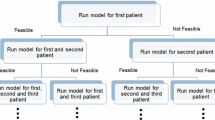Abstract
Optimal sequencing of urgent cases (i.e., selecting which urgent case should be performed first and which second) may enhance patient safety, increase patient satisfaction with timeliness of surgery, and minimize surgeons' complaints. Before determining the optimal sequence of urgent cases, an operating room (OR) suite must identify the primary scheduling objective to be satisfied when prioritizing pending urgent cases. These scheduling objectives may include: 1) perform the cases in the sequence that minimizes the average length of time each surgeon and patient waits; 2) perform the cases in the order that they were submitted; or 3) perform the cases based on medical priority, as prioritized by an OR director, or surgeons discussing the cases among themselves. We provide mathematical structure which can be used to program a computerized surgical services information system to assist in optimizing the sequence of urgent cases. We use an example to illustrate that the opti mal sequence varies depending on the scheduling objective chosen.
Similar content being viewed by others
REFERENCES
Smith WE. Various optimizers for single-stage produc-tion. Nav Res Log Quart 1956; 3: 59–66
Shukla RK, Ketcham JS, Ozcan YA. Comparison of subjective versus data base approaches for improving efficiency of operating room scheduling. Health Serv Manag Res 1990; 3: 74–81
Wright IH, Kooperberg C, Bonar BA, Bashein G. Statistical modeling to predict elective surgery time. Anesthesiology 1996; 85: 1235–1245
Hancock WM, Walter PF, More RA, Glick ND. Operat-ing room scheduling data base analysis for scheduling. J Med Syst 1988; 12: 397–409
Strum DP, May JH, Vargas LG. Surgical procedure times are well modeled by the log normal distribution. Anesth Analg 1998; 86: S47
Zhou J, Dexter F. Method to assist in the scheduling of add-on surgical cases-upper prediction bounds for surgical case durations based on the log normal distribution. Anesthesiology 1998; 89: 1228–1232
Randle MJ, Wolf A, Levi L, Rigamonti D, Mirvis S, Robinson W et al. Relationship between the timing of aneurysm surgery and the development of delayed cere-bral ischemia. J Neurosurg 1991; 75: 56–61
Hamlet WP, Lieberman JR, Freedman EL, Dorey FJ, Fletcher A, Johnson EE. Influence of health status and the timing of surgery on mortality in hip fracture patients. Am J Orthop 1997; 26: 621–627
Lau WY, Fan ST, Yip WC, Chu KW, Yiu TF, Yeung C et al. Acute appendicitis in children. Aust N Z J Surg 1987; 57: 927–931
Tucker JB, Barone JE, Cecere J, Blabey RG, Rha CK. Using queueing theory to determine operating room sta¤ng needs. J Trauma-Injury Infec Crit Care 1999; 46: 71–77
Miyazaki S. One machine scheduling with dual criteria. J Operat Res Soc Jpn 1981; 24: 37–50
Merkus JWS, Hoitsma AJ, Koene RAP. Detrimental e¡ect of acute renal failure on the survival of renal allografts: Influence of total ischaemia time and anasto-mosis time. Nephrol Dial Transplant 1991; 6: 881–886
Williams AB, Luchette FA, Papaconstantinou HT, Lim E, Hurst JM, Johannigman JA et al. The e¡ect of early versus late fasciotomy in the management of extremity trauma. Surgery 1997; 122: 861–866
Korhonen J, Kariniemi V. Emergency cesarean section: The e¡ect of delay on umbilical arterial gas balance and Apgar scores. Acta Obstet Gynecol Scand 1994; 73: 782–786
Martin RR, Burch JM, Richardson R, Mattox KL. Out-come for delayed operation of penetrating colon injuries. J Trauma 1991; 31: 1591–1595
Stephenson H, Dotters DJ, Katz V, Droegemueller W. Necrotizing fasciitis of the vulva. Am J Obstet Gynecol 1992; 166: 1324–1327
Author information
Authors and Affiliations
Rights and permissions
About this article
Cite this article
Dexter, F., Macario, A. & Traub, R.D. Optimal Sequencing of Urgent Surgical Cases. J Clin Monit Comput 15, 153–162 (1999). https://doi.org/10.1023/A:1009941214632
Issue Date:
DOI: https://doi.org/10.1023/A:1009941214632




